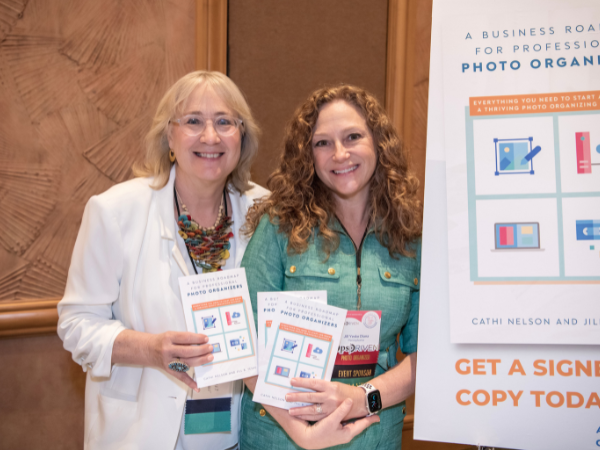I like to joke that my company was a 15-year overnight success story.
I never set out to start a business. As an early adopter of digital photography, I regularly had friends and family turn to me for help. They’d bring over bags of memory cards, asking what to do with them, or hoped to digitize the boxes of printed photos gathering dust in their basement. I loved digging through people’s memories, so I initially did it for free as a fun hobby.
Then one day, a friend asked what I would charge to help organize her photos and create an album of her dad. I told her I didn’t charge anything, and she said, “I paid a professional organizer to help me organize my house. I guarantee hundreds of people would pay someone to organize their photos.”
What started as a few hundred dollars per week quickly transformed into a lucrative side hustle, bringing in over $3,000 per month.
Then, another surprise opportunity came my way. People started asking me if I would teach them not only how to organize photos, but also how to build a business around it. Again, I initially helped them for free but then realized I was giving away valuable intellectual property.
It had taken me months to refine my positioning, offerings, and workflows — why couldn’t I charge for that, too?
So, in 2009 The Photo Managers was born: an association that helps others start their own photo-organizing businesses. For a quarterly or annual fee, members gain access to a certification program, continued education via courses and monthly webinars, and a supportive community via a Facebook Group, meetups, and conferences.
Running this association has become my full-time job. I feel privileged to earn an excellent income and have employees and subcontractors while helping hundreds of people grow successful businesses.
If I had to summarize my secret to success, it’s that I continuously said yes to opportunities, relationships, and new directions for the business — and then found ways to leverage them effectively. But, looking back over the past 15 years, here are some specific tactics that have made The Photo Managers what it is today.
I fostered win-win partnerships with complementary businesses
Strategic alliances with software, photo-sharing, printing, and archival businesses have played a crucial role in our growth.
For example, Mylio has created excellent photo organization software that I could have easily ignored or viewed as a competitor. Instead, I thought about the customer experience: People often purchase new software, get overwhelmed or frustrated when they can’t figure it out, and then abandon it.
I realized that we could turn this into an opportunity by having Mylio train our photo managers on their products, allowing us to act as their boots-on-the-ground tech support.
Creating win-win partnerships with many companies allows us to ride on the coattails of their larger audiences and budgets. We do this by bringing our expertise through teaching webinars, writing blogs, and sharing content with our partners on photo organization topics.
Thanks to their reach, thousands of people will sign up, and we’ll use a lead magnet to collect those emails and grow our audience of people who care about preserving memories and might be interested in a career in photo management. Plus, our members often get discounts on partner products, creating another incentive to join or renew their membership.
To build these partnerships, I show up in spaces where I can meet new people in complementary industries. I also like to think outside of the box of photography events, exhibiting for organizations like The National Association of Senior Move Managers, which helps older folks downsize, or Roots Tech, a large genealogy conference full of people who care about documenting family history. Over the years, this has led to partnerships with over 30 diverse businesses.
I show up knowing what we can bring to the table: we’ve built trust in our communities as experts in photos, stories, legacy storytelling, and memory-keeping and can provide phenomenal education to customers. From there, we can start a conversation about how we can help each other succeed.
I used the power of community to keep customers for years
What draws customers to join The Photo Managers initially is education: We’re essentially giving them a business in a box with all of the information they need to get started. Unfortunately, companies with this model typically lose customers as soon as their businesses are up and running.
I lost sleep for years brainstorming ways to continue providing value for customers as long as they’re running a photo organization business. After talking to members and paying attention to what they valued, I realized that the secret sauce is community.
I also knew from my own experience that being a solo entrepreneur is lonely. Even though our members are all independent business owners who could technically see each other as competitors, we’ve worked hard to foster an environment of collaboration and support.
Within a few years of owning the business, we launched an annual conference where members could learn from each other. We started a Facebook group and regional groups that meet monthly on Zoom. We work hard to welcome every new member and encourage regular engagement. We even have an internal award that allows members to nominate others who represent what it means to be an exemplary photo manager.
This community has become a core part of our business, and it’s what members often mention when we survey them about their experience with The Photo Managers. Life-long friendships have formed, contributing to our low turnover. We also created a lower-cost membership tier for people who had retired from the industry but wanted to stay engaged in the social aspect.
People are wired for connection. Even if community isn’t core to your business, it’s worth thinking about how to foster those relationships between your customers. The better sense of connection you can give your audience, the more they’ll be excited to stay engaged.
I focused on storytelling and human connection in marketing
So much of what we do as photo organizers is to help people tell stories and bring out the human side of their photos, and I’ve learned the importance of that in how we market ourselves as well.
It’s easy to describe what we do in a way that sounds boring, almost like watching paint dry. If I said, “I’m going to organize your photos,” you probably wouldn’t be particularly inspired. But with a more value-based framing — “Do you have a box of photos somewhere? What if I could help you discover a photo of your grandfather with a story you’ve never heard?” — you’ll probably be much more interested.
In messaging, the why typically matters more than the how, so my team constantly asks ourselves: Who are we for? Why does what we do matter to them?
Finally, I always keep the human touch front and center. I know I’d be skeptical about joining an online program without knowing who is behind it, so I keep myself available to connect with potential customers. We also have member volunteers who will meet with prospective new members, willingly giving their time to help grow the industry. I’m constantly out there networking and telling others about the business.
I host a live Q&A monthly and keep my calendar booking link on our website for anyone to schedule a 15-minute call with me.
Perhaps even more so in today’s online world, one of the most powerful ways to grow a business is to stop hiding behind your computer. Get out into your community, meet people, and see how your expertise can help solve their problems. You never know where those relationships will go from partnerships to dedicated customers.






